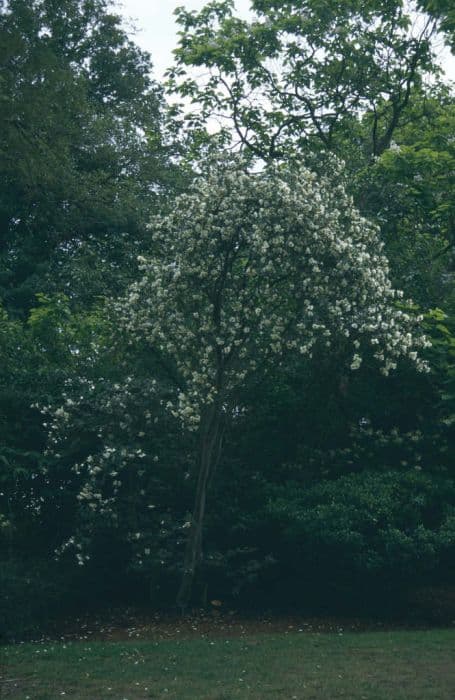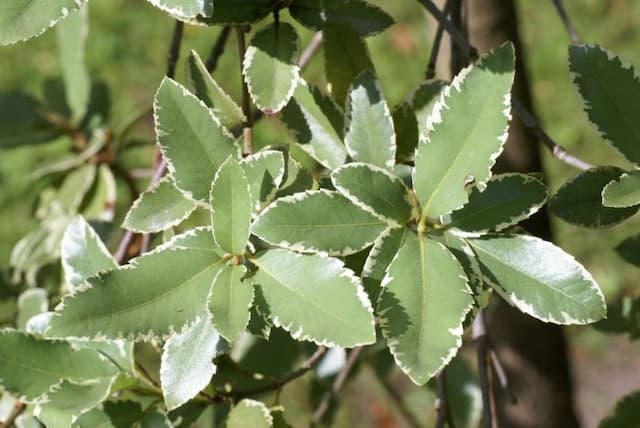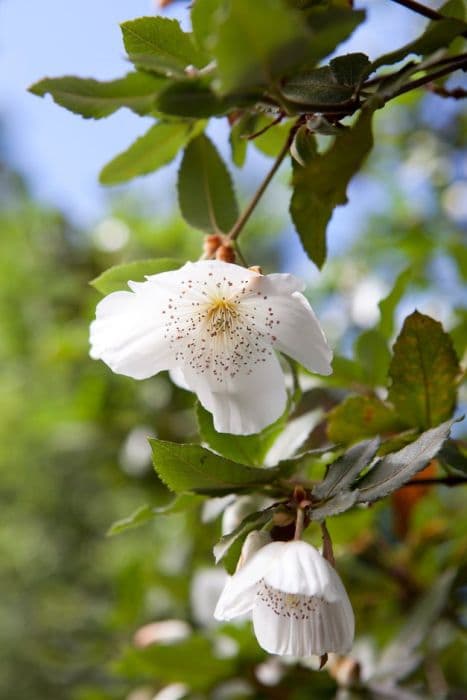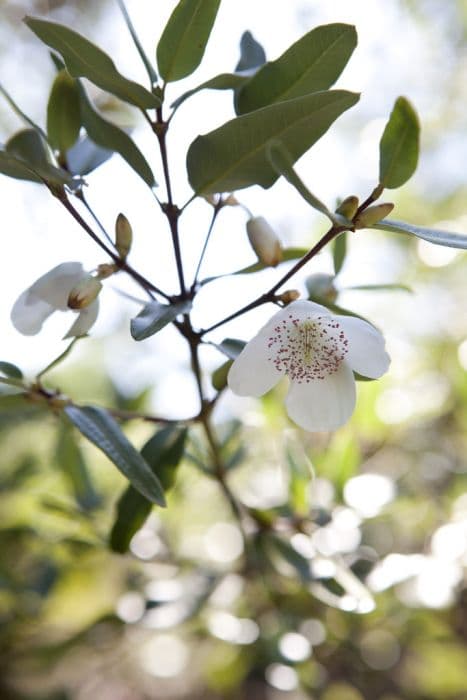Nyman's eucryphia Eucryphia × nymansensis

ABOUT
Eucryphia × nymansensis, commonly referred to as Nymansay eucryphia, is a hybrid plant that boasts a glossy and evergreen foliage. The leaves are typically dark green, and they present a leathery texture which can be both pleasing to the eye and touch. Each leaf is oppositely arranged on the stems, creating a symmetrical appearance that adds to its ornamental value. The most striking feature of Nymansay eucryphia is its flowers. The blooms are large and showy, with a radiant white color that can light up a garden. The petals are broad and somewhat rounded, converging to form a cup-like shape that elegantly displays the delicate central stamens, usually tinged with a hint of yellow, adding contrast and depth to the overall flower structure. These blossoms generally appear in late summer or early autumn, offering a fresh spectacle when many other plants are starting to fade. The overall aesthetic of Nymansay eucryphia is one of stately beauty, with its contrasting dark leaves and bright white flowers. It adds a layer of texture and color to gardens and landscapes, making it a favorite among gardeners who seek to create a visually engaging environment.
About this plant
 Names
NamesFamily
Cunoniaceae
Synonyms
Nymans Eucryphia, Nymans Hybrid Eucryphia
Common names
Eucryphia × nymansensis
 Toxicity
ToxicityTo humans
The Eucryphia × nymansensis, commonly known as the Nymansay Eucryphia, is not widely documented to be toxic to humans. However, in the absence of specific toxicity information, it is always wise to be cautious and avoid ingesting parts of ornamental plants due to potential unknown risks.
To pets
Similar to its effects on humans, the Nymansay Eucryphia does not have a well-documented record of toxicity to pets. Nonetheless, as with any plant not typically a part of a pet’s diet, it is advisable to prevent pets from ingesting this plant as a precautionary measure to avoid any possible adverse reactions.
 Characteristics
CharacteristicsLife cycle
Perennials
Foliage type
Evergreen
Color of leaves
Green
Flower color
White
Height
20 feet (6 meters)
Spread
10 feet (3 meters)
Plant type
Tree
Hardiness zones
7
Native area
Hybrid
Benefits
 General Benefits
General Benefits- Ornamental Value: Eucryphia × nymansensis, commonly known as Nymansay Eucryphia, is highly valued for its ornamental appeal, with large, white flowers that add aesthetic beauty to gardens.
- Habitat Support: The plant provides habitat and food for various species of insects, including bees that are attracted to its flowers for nectar and pollen.
- Shade Provider: Its dense canopy can offer shade in gardens and parks, creating cooler areas during hot weather.
- Privacy Screen: When planted in groups or rows, it can act as a natural privacy screen, blocking unwanted views and reducing noise.
- Seasonal Interest: Nymansay Eucryphia has distinctive seasonal changes that interest gardeners, blooming in late summer to early autumn.
 Medical Properties
Medical PropertiesThis plant is not used for medical purposes.
 Air-purifying Qualities
Air-purifying QualitiesThis plant is not specifically known for air purifying qualities.
 Other Uses
Other Uses- Woodworking: Nyman's eucryphia's timber, being hard and durable, can be used for fine woodworking projects, including furniture and cabinetry.
- Beekeeping: The flowers of Nyman's eucryphia are a nectar source for bees, making it a valuable plant for honey production.
- Garden Aesthetics: With its showy white flowers, Nyman's eucryphia is used in ornamental gardens for aesthetic purposes to enhance visual appeal.
- Culinary Garnish: The flowers of Nyman's eucryphia, when not treated with chemicals, can potentially be used as decorative garnishes for culinary presentation.
- Creative Crafts: Dried branches and flowers of Nyman's eucryphia can be incorporated into floral arrangements or used in craft projects for their natural beauty.
- Fragrance Extraction: The scent of Nyman's eucryphia flowers could be used in the production of natural perfumes and scents for potpourri.
- Ceremonial Use: In some cultures, plants like Nyman's eucryphia might be used in ceremonial or religious events due to their symbolic meanings or aesthetic qualities.
- Educational Tool: Nyman's eucryphia can serve as a botanical specimen for educational purposes, teaching about plant identification and reproduction.
- Photography: The picturesque nature of Nyman's eucryphia makes it a popular subject for garden and nature photographers.
- Wildlife Shelter: The thick foliage of Nyman's eucryphia provides shelter and nesting opportunities for birds and small mammals in garden settings.
Interesting Facts
 Feng Shui
Feng ShuiThe Eucryphia is not used in Feng Shui practice.
 Zodiac Sign Compitability
Zodiac Sign CompitabilityThe Eucryphia is not used in astrology practice.
 Plant Symbolism
Plant Symbolism- Adaptability: Eucryphia × nymansensis, also known as Nymansay Eucryphia, is a hybrid plant, symbolizing the concept of adaptability, as it combines the characteristics of two different species to thrive.
- Resilience: The ability of this plant to grow in various soil types and withstand different climates highlights resilience in the face of changing conditions.
- Beauty and Aesthetics: With its attractive flowers, the Nymansay Eucryphia is often associated with natural beauty and aesthetic appreciation.
- Harmony with Nature: As a garden plant that blends well into landscaped areas, it can represent a harmonious relationship with the natural world.
 Water
WaterFor the Tasmanian leatherwood, regular watering is crucial, especially during the first few years after planting to establish a strong root system. The soil should be kept consistently moist but not waterlogged. Watering should be done gently around the base of the plant to avoid disturbing the roots, providing about 1 gallon of water per week under normal conditions. However, during hot, dry spells, the plant may require additional water, increasing to 2 gallons per week to prevent stress.
 Light
LightTasmanian leatherwood prefers a location that receives full sun to partial shade. The ideal spot is one where it can enjoy morning sunlight with some afternoon shade, or dappled sunlight throughout the day, to avoid the intense heat of midday sun which may stress the plant.
 Temperature
TemperatureThe Tasmanian leatherwood thrives in moderate temperatures and can tolerate a range of conditions. Ideally, the temperature should be between 50°F and 70°F for optimal growth. The plant can withstand occasional temperatures as low as 20°F and as high as 80°F but prolonged exposure to these extremes can be harmful.
 Pruning
PruningPrune Tasmanian leatherwood to maintain shape and encourage healthy growth, usually after the flowering season ends. Selective pruning can be performed to remove any dead or damaged branches and to thin out dense growth, allowing light and air to reach the inner branches. Pruning should take place every year or every other year, depending on the plant's development and desired size.
 Cleaning
CleaningNot needed
 Soil
SoilThe Nymansay requires well-drained, moderately fertile soil with a pH of 5.5 to 6.5. A soil mix consisting of equal parts loam, leaf mold, compost and sharp sand is recommended to provide the right conditions for root growth and drainage.
 Repotting
RepottingNymansay, being a large shrub or small tree, is not typically repotted. It's planted in the garden where repotting is unnecessary. However, if grown in a container, repotting every few years in early spring is advisable as the plant matures.
 Humidity & Misting
Humidity & MistingNymansay thrives in moderate to high humidity levels, similar to what it would experience in its native woodlands. Maintaining a humidity level of 50-70% is ideal for this plant's well-being.
 Suitable locations
Suitable locationsIndoor
Grow Nymansay by a sunny window, in moist, acidic soil.
Outdoor
Plant Nymansay in partial shade, moist, well-drained, acidic soil.
Hardiness zone
8-10 USDA
 Life cycle
Life cycleEucryphia × nymansensis, commonly known as Nymansay Eucryphia, begins its life cycle as a seed, typically requiring stratification to break dormancy before it can germinate in conducive soil conditions. Upon germination, the seedling emerges and establishes itself, forming roots and shoots that will eventually become a young plant. The juvenile plant phase is characterized by rapid growth and the development of the distinctive foliage, with the plant eventually reaching maturity and forming a woody trunk and branching structure in several years. As it matures, Nymansay Eucryphia starts to bear flowers, which are typically large, white, and fragrant, attracting pollinators including bees and butterflies. After successful pollination, seeds are produced in capsules, completing the reproductive cycle. The mature Eucryphia × nymansensis can live for several decades, with flower production typically occurring annually throughout its lifecycle in late summer.
 Propogation
PropogationPropogation time
Spring to early summer
Eucryphia × nymansensis, commonly known as Nyman's eucryphia, is often propagated through semi-hardwood cuttings. This method is typically conducted in late summer, after the current season's growth has begun to mature. Cuttings about 4 to 6 inches (10 to 15 cm) long with several leaves are taken from the current year's growth. The lower leaves are removed, and the cut end is dipped into rooting hormone to encourage root development. The prepared cutting is then planted in a pot filled with a mix of perlite and peat moss. It's important to maintain a humid environment for the cutting, which can be achieved by covering the pot with a plastic bag or placing it in a humidity dome. The cutting should be kept in indirect light until roots have developed, which typically takes several weeks to a few months.




